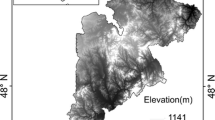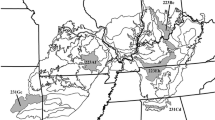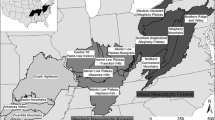Abstract
A fundamental but unsolved dilemma is that observation and prediction scales are often mismatched. Reconciling this mismatch largely depends on how to design samples on a heterogeneous landscape. In this study, we used a coupled modeling approach to investigate the effects of plot number and location on predicting tree species distribution at the landscape scale. We used an ecosystem process model (LINKAGES) to generate tree species response to the environment (a land type) at the plot scale. To explore realistic parameterization scenarios we used results from LINKAGES simulations on species establishment probabilities under the current and warming climate. This allowed us to design a series of plot number and location scenarios at the landscape scale. Species establishment probabilities for different land types were then used as input for the forest landscape model (LANDIS) that simulated tree species distribution at the landscape scale. To investigate the effects of plot number and location on forest landscape predictions, LANDIS considered effects of climate warming only for the land types in which experimental plots were placed; otherwise inputs for the current climate were used. We then statistically examined the relationships of response variables (species percent area) among these scenarios and the reference scenario in which plots were placed on all land types of the study area. Our results showed that for species highly or moderately sensitive to environmental heterogeneity, increasing plot numbers to cover as many land types as possible is the strategy to accurately predict species distribution at the landscape scale. In contrast, for species insensitive to environmental heterogeneity, plot location was more important than plot number. In this case, placing plots in land types with large area of species distribution is warranted. For some moderately sensitive species that experienced intense disturbance, results were different in different simulation periods. Results from this study may provide insights into sample design for forest landscape predictions.






Similar content being viewed by others
References
Aber JD, Ollinger SV, Driscoll CT, Likens GE, Holmes RT, Freuder RJ, Goodale CL (2002) Inorganic N losses from a forested ecosystem in response to physical, chemical, biotic and climatic perturbations. Ecosystems 5:648–658
Abrahamson IL, Nelson CR, Affleck DLR (2011) Assessing the performance of sampling designs for measuring the abundance of understory plants. Ecol Appl 21(2):452–464
Bechtold WA, Patterson PL (2005) The enhanced forest inventory and analysis program—national sampling design and estimation procedures. Gen Tech Rep SRS-80. Asheville: U.S. Department of Agriculture, Forest Service, Southern Research Station p 85
Chen JQ, Bradshaw AG (1999) Forest structure in space: a case study of an old growth spruce-fir forest in Changbaishan Natural Reserve, PR China. For Ecol Manage 120:219–233
Chi ZW, Zhang FS, Li XY (1981) Preliminary analysis on the climate of the Changbai mountain area. Res For Ecosyst 2:179–186
Chiesi M, Chirici G, Barbati A, Salvati R, Maselli F (2011) Use of BIOME-BGG to simulate Mediterranean forest carbon stocks. Forest 4:121–127
Congalton RG (1991) A review of assessing the accuracy of classifications of remotely sensed data. Remote Sens Environ 37:35–46
Eastaugh CS, Pötzelsberger E, Hasenauer H, Abrams M (2011) Assessing the impacts of climate change and nitrogen deposition on Norway spruce (Picea abies L. Karst) growth in Austria with BIOME-BGC. Tree Physiol 31(3):262–274
Fang JY, Wang GG, Liu GH, Xu SL (1998) Forest biomass of China: an estimation based on the biomass-volume relationship. Ecol Appl 8:1084–1091
Fang JY, Chen AP, Peng CH, Zhao SQ, Ci LJ (2001) Changes in forest biomass carbon storage in China between 1949 and 1998. Science 292:2320–2322
Han YZ, Wang ZQ (2002) Spatial heterogeneity and forest regeneration. J Appl Ecol 13(5):615–619
Hao ZQ, Dai LM, He HS, Mladenoff DJ, Shao GF (2001) Potential response of major tree species to climate warming in Chingbai mountain. Chin J Appl Ecol 12:653–658
He HS, Mladenoff DJ (1999) Effects of seed dispersal in the simulation of long-term forest landscape change. Ecosystems 2:308–319
He HS, Mladenoff DJ, Crow TR (1999) Linking an ecosystem model and a landscape model to study forest species response to climate warming. Ecol Model 112:213–233
He HS, Hao ZQ, Larsen DR, Dai LM, Hu YM, Chang Y (2002) A simulation study of landscape scale forest succession in northeastern China. Ecol Model 156:153–166
He HS, Hao ZQ, Mladenoff DJ, Shao GF, Hu YM, Chang Y (2005) Simulating forest ecosystem response to climate warming incorporating spatial effects in north-eastern China. J Biogeogr 32:2043–2056
He HS, Keane RE, Iverson LR (2008) Forest landscape models, a tool for understanding the effect of the large-scale and long-term landscape processes. For Ecol Manage 254:371–374
Hewitt JE, Thrush SF, Dayton PK, Bonsdorff E (2007) The effect of spatial and temporal heterogeneity on the design and analysis of empirical studies of scale-dependent systems. Am Nat 3(169):398–407
Jansen M, Bredemeier M (2004) Interdisciplinary forest ecosystem experiments at Solling, Germany—from plot scale to landscape level integration. For Snow Landsc Res 78(78):33–52
Jenkins JC, Birdsey RA, Pan Y (2001) Biomass and NPP estimation for the mid-atlantic region (USA) using plot-level forest inventory data. Ecol Appl 11(4):1174–1193
Leng WF, He HS, Bu RC, Hu YM (2007) Sensitivity analysis of the impacts of climate change on potential distribution of three larch(larix) species in northeastern China. J Plant Ecol 31(5):825–833
Leng WF, He HS, Bu RC, Dai LM, Hu YM, Wang XG (2008) Predicting the distributions of suitable habitat for three larch species under climate warming in Northeastern China. For Ecol Manage 254:420–428
Liang Y, He HS, Bu RC, Hu YM, Shao GF (2011a) Are plot data effective for landscape prediction: a simulation study of tree species response to climate warming under varying environmental heterogeneity. Ann For Sci 68:899–909
Liang Y, He HS, Lewis BL (2011b) Responses of tree species to climate warming at different spatial scales. Chin Geogr Sci 21(4):427–436
Liu QJ (1997) Structure and dynamics of the subalpine coniferous forest on Changbai mountain, China. Plant Ecol 132:97–105
Meigs GW, Turner DP, Ritts WD, Yang ZQ, Law BE (2011) Landscape-scale simulation of heterogeneous fire effects on pyrogenic carbon emissions, tree mortality, and net ecosystem production. Ecosystems 14(5):758–775
Miller JR, Turner MG, Smithwick EAH, Dent CL, Stanley EH (2004) Spatial extrapolation: the science of predicting ecological patterns and processes. Bioscience 54(4):310–320
Mladenoff DJ, He HS (1999) Design and behaviour of LANDIS, an object-oriented model of forest landscape disturbance and succession. In: Mladenoff DJ, Baker WL (eds) Advances in spatial modeling of forest landscape change: approaches and applications. Cambridge University Press, Cambridge, pp 125–162
Ollinger SV, Aber JA, Federer CA (1998) Estimating regional forest productivity and water yield using an ecosystem model linked to a GIS. Landscape Ecol 13:323–334
Peignéa J, Vian JF, Cannavacciuolo M, Bottollier B, Chaussod R (2009) Soil sampling based on field spatial variability of soil microbial indicators. Eur J Soil Biol 45(5–6):488–495
Post WM, Pastor J (1996) Linkages–an individual-based forest ecosystem model. Clim Change 34:253–261
Rastetter EB, Aber JD, Peters DPC, Ojima DS, Burke I (2003) Using mechanistic models to scale ecological processes across space and time. Bioscience 53(1):68–76
Schmitz OJ (2005) Scaling from plot experiments to landscapes: studying grasshoppers to inform forest ecosystem management. Oecologia 145:225–234
Shao GF, Schall P, Wishampel JF (1994) Dynamic simulations of mixed boradleaved-Pinus koriensis forests in the Changbaishan biosphere reserve of China. For Ecol Manage 70:169–181
Shao GF, Zhao G, Shugart HH, Wang S, Schaller J (1996) Forest cover types derived from landsat thematic mapper imagery for the Changbai mountain area of China. Can J For Res 26:206–216
Stehman SV, Wickham JD, Smith JH, Yang L (2003) Thematic accuracy of the 1992 National Land-Cover data for the eastern United States: statistical methodology and regional results. Remote Sens Environ 86:500–516
Stone R (2006) A threatened nature reserve breaks down Asian borders. Science 313(5792):1379–1380
Underwood N, Hamback P, Inouye BD (2005) Large-scale questions and small-scale data: empirical and theoretical methods for scaling up in ecology. Oecologia 145:177–178
Wang Z, Xu Z, Tan Z, Dai H, Li X (1980) The main forest types and their features of community structure in northern slope of Changbai mountain. For Eco Res 1:25–42
Wickham JD, Stehman SV, Fry JA, Smith JH, Homer CG (2010) Thematic accuracy of the NLCD 2001 land cover for the conterminous United States. Remote Sens Environ 114:1286–1296
Yan XD, Zhao SD (1996) Simulating the response of Changbai Mt. forests to potential climate change. J Environ Sci 8:354–366
Yang H, Li D (1985) Distribution patterns of dominant tree species on northern slope of Changbai mountain. Res For Ecosyst 5:1–14
Zhao SD, Yan XD, Yang SH, Tao DL, Dai LM (1998) Simulating responses of northeastern China forests to potential climate change. J For Res 9(3):166–172
Zhao SQ, Fang JY, Zong ZJ, Zhu B, Shen HH (2004) Composition, structure and species diversity of plant communities along an altitudinal gradient on the northern slope of Mt. Changbai, Northeast China. Chin Biodivers 12(1):164–173
Zheng DL, Wallin DO, Hao ZQ (1997) Rates and patterns of landscape change between 1972 and 1988 in the Changbai mountain area of China and North Korea. Landscape Ecol 12(4):241–254
Acknowledgments
Funding for this research was provided by “the 973 project” 2011CB403206 and Chinese National Science Foundational Project 41071120. We thank Thorsten Wiegand and anonymous reviewer for providing constructive comments that greatly improved the manuscript.
Author information
Authors and Affiliations
Corresponding author
Electronic supplementary material
Below is the link to the electronic supplementary material.
Rights and permissions
About this article
Cite this article
Liang, Y., He, H.S., Yang, J. et al. Coupling ecosystem and landscape models to study the effects of plot number and location on prediction of forest landscape change. Landscape Ecol 27, 1031–1044 (2012). https://doi.org/10.1007/s10980-012-9759-7
Received:
Accepted:
Published:
Issue Date:
DOI: https://doi.org/10.1007/s10980-012-9759-7




